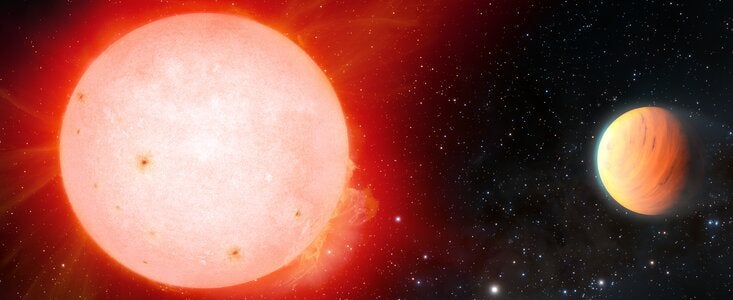Astronomers discover ‘fluffiest planet ever’ with the density of a marshmallow
The planet TOI-3757 b would float if placed in a large enough bathtub

Your support helps us to tell the story
From reproductive rights to climate change to Big Tech, The Independent is on the ground when the story is developing. Whether it's investigating the financials of Elon Musk's pro-Trump PAC or producing our latest documentary, 'The A Word', which shines a light on the American women fighting for reproductive rights, we know how important it is to parse out the facts from the messaging.
At such a critical moment in US history, we need reporters on the ground. Your donation allows us to keep sending journalists to speak to both sides of the story.
The Independent is trusted by Americans across the entire political spectrum. And unlike many other quality news outlets, we choose not to lock Americans out of our reporting and analysis with paywalls. We believe quality journalism should be available to everyone, paid for by those who can afford it.
Your support makes all the difference.A planet with the density of a marshmallow has been discovered by scientists.
The planet, identified as TOI-3757 b, is the fluffiest ever found, orbiting around a cool red dwarf star approximately 580 light-years from Earth in the constellation of Auriga the Charioteer.
The star has a diameter of 150,000 kilometres, making it slightly larger than Jupiter, and orbits its host star once every 3.5 days. The research team calculated TOI-3757 b’s average density as being 0.27 grams per cubic, which is about one quarter the density of water – and would float if placed in a large enough bathtub.
Red dwarf stars are the smallest and dimmest type of ‘main-sequence stars’ – stars that convert hydrogen into helium in their cores – at a steady rate. These stars, while colder compared to the Sun, can erupt in powerful flares and as such make it rare for planets to form around them.
“Giant planets around red dwarf stars have traditionally been thought to be hard to form,” said Shubham Kanodia, a researcher at Carnegie Institution for Science’s Earth and Planets Laboratory.
“So far this has only been looked at with small samples from Doppler surveys, which typically have found giant planets further away from these red dwarf stars. Until now we have not had a large enough sample of planets to find close-in gas planets in a robust manner."
Some mysteries still surround TOI-3757 b that scientists will have to solve – the biggest being how the planet could have even formed, especially with its low-density. One answer could be that the planet has a lower number of heavy elements in its rocky core compared to other gas giants, which may have delayed how the gas accumulates and lowered its density.
The second factor could be that the planet’s slightly elliptical orbit results in substantial excess heating when it gets close to its star – causing the planet’s atmosphere to bloat.
“Potential future observations of the atmosphere of this planet using NASA’s new James Webb Space Telescope could help shed light on its puffy nature," says Jessica Libby-Roberts, a postdoctoral researcher at Pennsylvania State University. The research could help astronomers understand what the planets are made of and how they formed and, for potentially habitable rocky worlds, whether they might be able to support life.
Join our commenting forum
Join thought-provoking conversations, follow other Independent readers and see their replies
Comments